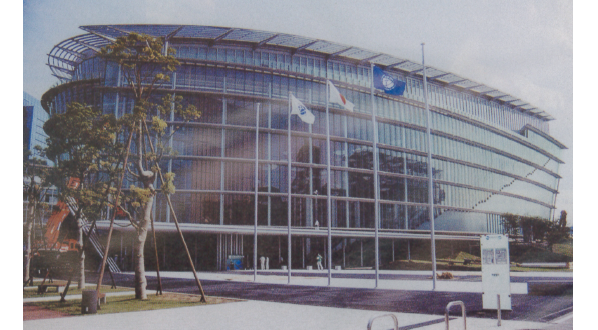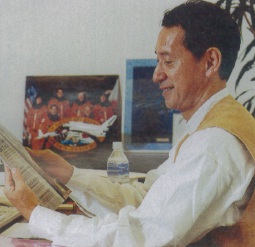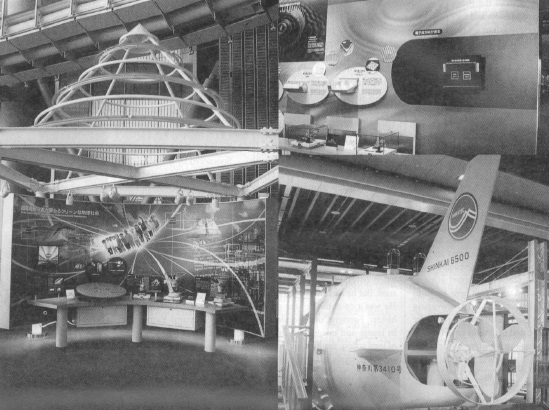Story by Jim Merk
Photos by Dov Friedmann
Almost nine years ago—on Sept. 12, 1992, to be precise—Dr. Mamoru Mohri was togged out in his NASA astronaut pressure suit, helmeted and flat on his back aboard STS-4 Spacelab-J Endeavor, waiting with his fellow astronauts to blast off on a mission that eventually would help to enlighten Japanese children on scientific wonders for years to come. Eight years later, Feb. 11-22, 2000, he was once again aboard as a mission specialist.
Thus, as the first Japanese astronaut, Mohri logged more than 459 hours in space, traveling approximately 7.3 million miles in the vast darkness of outer space.
This month will mark another milestone in the remarkable career of Mamoru Mohri when the National Museum of Emerging Science and Innovation, of which he is director, opens in Odaiba.
Mamoru Mohri is famous as Japan’s first astronaut. However, he is much more than just that historical footnote. He is a compassionate man with vision who tirelessly pursues his lofty goals. His time in space was spent not only on mission duties, but also teaching children—part of a lifelong dedication to education. He is the director of the Young Astronauts Club which stimulates children’s interest in space and which now has 72 chapters around Japan.
In his chosen field of material and vacuum sciences, he has published more than 100 papers. For his impact on education and in the scientific community, he has been honored by a large variety of institutions and organizations, including awards from the Prime Minister, and even the Tokyo American Club. Although he still trains with NASDA (National Space Development Agency) as an astronaut, he now also serves as director of the National Museum of Emerging Science and Innovation in Odaiba.
From his museum offices, Dr. Mohri spoke with me.
Weekender: Is there much of a difference between working at NASDA and NASA?
Mohri: There is a big difference. You can feel it as soon as you get there. NASA has a long history, of course, bigger budget (about 10 times the size of NASDA), and it also has a budget from the defense agency. Interestingly, though, with regard to the international space station, NASDA is contributing 12.8% of the total—larger than the contribution of the European space agency.
NASDA has eight astronauts and, when the Japanese module is completed, we will have the right to keep one astronaut on board for six months of the year. We will be able to conduct a lot of research—it will have a big impact on scientific development in Japan. I think this will have a big impact on the things I am doing with children, not only on Japan’s science ability as a whole.
W: What do you think of the civilian who bought his way into space?
M: Tito-san? Well, as a trained astronaut, I don’t like it. We dedicate our lives to be able to make a few trips to space; they are not just pleasure trips.
Perhaps, though, it signals a change—a new approach to the space program that includes so-called ordinary people. In this sense, I like it. You know, I am called the first Japanese astronaut in space, but I am not the first Japanese person in space. The first Japanese in space was TBS journalist Toyohiro Akiyama. Not only was he the first Japanese in space, but he was also the first paying tourist. His flight cost TBS $28 million. Tito only paid $20 million.
W: Obviously, he is a good businessman.
M: (laughing) Yes, that’s right. Almost 30% saved. Anyway, Japan actually had the first tourist in space. Akiyama, too, went up with the Russians.
W: Why didn’t we hear about that, when the furor around Tito was going on?
M: NASA didn’t like that trip either. So when you look at the list of astronauts at the Smithsonian, my name is first and Akiyama isn’t even mentioned. But he did a very good job. He made daily broadcasts and talked about things that astronauts never mention. It was very interesting.
W: What was your own first impression of space?
M: Astronauts often talk about how beautiful the Earth is from space. It is true. The Earth is a vibrant blue, the kind of blue you see when looking at a Bunsen burner. What I didn’t know or expect, was how dark it is in space. Completely black, it doesn’t reflect any light. Of course, the stars are bright, but the blackness of space really took me by surprise. Very different than what you see on Earth, where you have a shade of blue even on the darkest nights.
W: Did it make the heavens seem even more vast?
M: Actually, just the opposite. You could feel the dome of space. I don’t know how to explain it, but the curvature of space is apparent.
W: On your first trip to space, you performed experiments that were televised to children in classrooms in Japan. How did you come up with that idea?
M: I did a space education program in collaboration with NHK. My flight was delayed by the tragic Challenger explosion. That flight was a new direction for NASA. After a long deliberation on what type of civilian they should send into space, they decided it would be best to send a teacher. Of course, that was Christa McAuliffe. As a university professor, I was very interested in this new direction and followed the flight closely. After the tragedy, I decided to do the classroom series as a tribute to her.
You know the logo for her classroom in space was an apple—it was even on her NASA patch, and Newton discovered gravity because of an apple, so my first televised experiment from space was a demonstration of weightlessness using an apple.
W: When did you get the idea for the museum?
M: During my second mission, I also did classroom-in-space activities. The second was fun, too. In a collaboration with NASA, NASDA and NHK, we set up a camera in the ceiling of the shuttle. This camera was controlled by children via the Internet to take pictures of space which were then downloaded into the classroom. When I got back, the director of this project, Hiroyuki Yoshikawa, got in touch with me and asked if I would be the director for the museum. I researched the purpose and the planned activities of the museum, and thought, “Wow, this is the job I want to do next.” It gives me a chance to contribute to society in an educational endeavor, which I feel very strongly about.
After looking at the proposed overall goals of the museum, I created a more specific set of goals and proposals, which the committee accepted. So I joined and became director.
W: What types of things did you propose?
M: The fundamental idea of the museum was already in place—a showcase of scientific development. I proposed that the museum, in addition, be participatory—by visitors to the museum itself or to our Website. I want the museum to be the place where we can bring scientists to the people. Perhaps in this way, we can make heroes of our scientists.
I hoped that the museum would be a place where scientific experiments are carried out and where visitors can have an impact on those experiments. People will visit and not only learn about the scientists discovering tomorrow’s technology, but also be part of the process.
W: Can you give me an example of how will you accomplish this feat?
M: Sure. Let me tell you about one of our exhibits in the field of robotics. Have you seen Hikaru Utada’s latest video? She is shown with a robot called Pino. Pino was developed here by Hiroaki Kitano’s excellent team.
We have an exhibit on robotics based on Pino and visitors will help with his development as he grows up.
W: What do you mean by “people can help develop?” Develop the robot program or enjoy the exhibit?
M: Pino is an attempt to re-create human-like development. Pino hasn’t been programmed to do things, but rather has been programmed to learn. He was born on Apr. 28 and hasn’t learned to do too many things yet. Visitors to the museum will be able to give suggestions regarding his development.
Right now, Pino can walk and kick a ball. Perhaps, though, people think it will be interesting to see Pino walk smoother, or sing—who knows? Those suggestions, though, will be given to the development team, which will try to implement them. So, after three years, he will develop via the suggestion of the visitors. Probably he will be much more clever.
W: Do you see your vision for the museum coming through?
M: My contribution is not with the exhibits, but more on a philosophical plane. For example, I have seen Earth from space. Ever since, T have been thinking how can I show this beautiful planet to others in the way I experienced it. So we had a special sphere of LEDs built. It is a spherical TV, if you will. It has a diameter of 6.5 meters. Each LED (3,389 in total) corresponds to 20 square kilometers on Earth. The resolution is very high. We can show what is happening on Earth in real time.
To do this, we are getting information from a satellite operated by the Goddard Space lab. But we can use the sphere in many ways. If an earthquake hits, we can show how it affects the planet. We can also use it to mimic the sun and show sunspots. It could, just as easily, simulate Mars or Jupiter. We call the sphere Geo-Cosmos.
To experience the earth we have an oval bridge that goes around it—you get to orbit the earth. But you won’t just see the earth; it will have sound, too. I asked Ryuichi Sakamoto to create the music. He had a great idea.
He thought that a simple composition wouldn’t be enough. He wanted nature to compose the music. For example, the wind direction might be one of the rules and as the direction changes, so does the modal line for whatever instrument is tied to the wind direction. Another might be precipitation—all sorts of natural factors will combine to create an ongoing symphony for the listeners. I am very excited to hear what he will create. In ways such as this, I do see my vision for the museum taking shape.
W: How long do you see yourself as director?
M: At least five years. But I want to make sure that what I do has an impact on the Japanese education system and that might take a bit longer.
W: Do you see a need for change?
M: Yes. Students hate science—especially middle and high school students. I can understand because of the manner in which it is taught. But science explains nature and school children are curious. I want them to come here or visit us on the Internet and find the enjoyment science can provide. If we can keep children’s natural curiosity and provide a way to explore it and reaffirm them, then I think the future is very bright.
The museum opened July 10 and is open at the following times: Sunday to Thursday, 10 a.m. to 5 p.m. (last entry 4:30). Friday and Saturday, 10 a.m. to 7 p.m. (last entry 6:30 p.m.). Admission is ¥200 for those between the ages of 6 and 18, and ¥500 for adults.
Tokyo’s coolest museum
National Museum of Emerging Science and Innovation
In Japanese it will be known as Mirai Can. The museum (the can) is a place full of things about the future (mirai). The museum is also a place where people “can” see, experience and have an impact on the future. Mirai Can. Fitting.
The place itself is in Odaiba, not far from the Maritime Museum. It is situated on 20,000 square meters of land and within its eight floors you will find much that fires the imagination: three special theaters with the Dome Theater GAIA—a 123-seat theater in the round, taking the highlight. Half of its dome serves as the screen and, because of the shape, round objects, such as planets and sky shots, are reproduced with added realism.
A scientific library with cutting edge videos you can enjoy on the provided large screen viewing terminals.
Tons of exhibits, including ones covering: the genome project, underwater exploration, nanotechnology, micromachines, information technology (complete with a working mini-Internet), symbiotic housing and this month’s visiting exhibit, “innovative thinkers of the Renaissance” featuring works of Michelangelo. Each of these exhibits is designed by top engineers and thinkers in their field—keeping true to Mohri’s vision of bringing scientists to the people.
There are a variety of small halls for presentations and discussion (nothing is to be a lecture). There will be researchers carrying out experiments who will expect and encourage your questions regarding their work at hand. Mohri at work again.
In such a place, it is easy to burn time. Since it is so close and accessible, you needn’t worry about spending too much time at one exhibit—at some point you may become utterly captivated with what you see, forcing you to miss other things. Come back and explore often. The museum’s exhibits will change on a regular basis and the halls will often be filled with scientists leading discussions. You will always discover something new and exciting.
Ideal Age Groups: Although it is never too early to instill a love of science in your children, this place is best suited to late primary/middle-school students and above. The wow factor is hard for any age group to miss, while the interaction is more suited to the older age groups.
Getting there: You can drive and take advantage of the 197-space parking lot. Or you can take the water-bus from Hinode Pier (close to the Tokyo Bay Intercontinental Hotel) to Fune-no-Kagakukan. The closest train station, the Telecom Center Station, is on the Yurikamome Line.
For maps, more information and other details, visit the museum’s Website at www.miraikan.jst.go.jp and look for the English links.
Jim Merk
Updated On April 26, 2021










